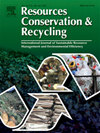投稿信息
稿件收录要求
The Editors welcome contributions from research, which consider all aspects of resource management, particularly with regard to conservation and sustainability objectives. The journal emphasizes the transformation processes involved in a transition toward more sustainable production and consumption systems. Emphasis is upon technological, economic, institutional and policy aspects of specific resource management practices, such as conservation, recycling and resource substitution, and of "systems-wide" strategies, such as resource productivity improvement, the restructuring of production and consumption profiles and the transformation of industry. Contributions may have relevance at regional, national or international scales and may focus at any level of inquiry from individual resources or technologies to whole sectors or systems of interest. Contributors may emphasise any of the aforementioned aspects as well as scientific and methodological issues. However, submissions which consider process developments at laboratory or pilot scale whose application potential in a practical, economic sense is not evident and that have not yet seen widespread testing or application are discouraged. The journal publishes papers, reviews, analyses and case studies on topics, which include: Transformation of the industrial and societal system towards more sustainable production and consumption patterns, including management, instruments, methods and processes of change. Information and management systems involving resource status, use and flows in society. Innovation processes, tools and methods relating to resource productivity improvement. Technical, societal, economic, business and policy aspects of strategies to improve the sustainability and productivity of resource use, including strategies for managing resource supply and demand, valorizing waste, lowering energy and material intensities and increasing the serviceability of products. Substitution of primary resources by renewable or regenerative alternatives, including agricultural and forest resources and wastes. Life cycle assessment and management of resources, materials and products to improve resource efficiency and productivity, conserve resources and reduce pollution. Societal, economic and technological change for improved recovery and reuse of materials and energy from domestic, commercial or industrial waste streams. Efficient management and use of all resources, including air and water, with regard to the qualitative as well as quantitative aspects of resource use.




